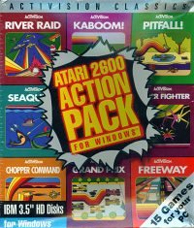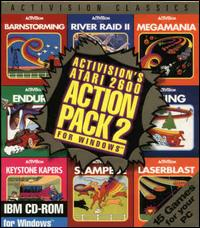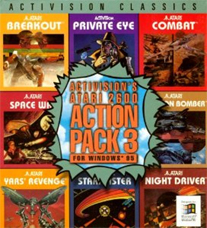

The Great Market Crash: Coda
By Scott Stilphen
Many in the media at the time were proclaiming the home computer market to be the only option left for video gamers. The few video game magazine at the time that were still being published had revamped their formats to support home computers. However, at the same time the home video game console and arcade video game markets were going down in flames, a brutal price war instigated by Jack Tramiel had equally devastated home computer manufacturers. What initially started as a campaign by Commodore to drive Texas Instruments from the business soon engulfed everyone else. Besides Texas Instruments with their line of TI computers - the most successful being the TI-99/4a - you had Apple with their venerable Apple II, Atari with their 400/800/XL models, Coleco with their ADAM (although Coleco was doing a pretty good job of sinking themselves with a system that was poorly designed and rushed to market), IBM with their PCjr (who also made some serious design flaws of their own, particularly with their infamous 'chicklet' keyboard), Radio Shack with their line of Tandy models, and Timex with their Sinclair 1000. The latter had established the low-end price point of the home computer market with their $100 computer, and Tramiel was determined to force Commodore to dominate that market. Thanks to Commodore's purchase of MOSET, they had the advantage of what's called 'vertical integration'. In other words, they owned the chip fabricator who supplied chips for their products. With that advantage, Tramiel was able to instigate and sustain his price war.
After being ousted from Commodore, Tramiel set up his own company, Tramel Technologies, Ltd. (he intentionally misspelled his name since most people incorrectly pronounced it as "tra-meal" instead of "tra-mel") on May 17th with $75 million from unnamed investors, and renamed his company Atari Corporation with the purchase of these Atari divisions (InfoWorld August 6th, 1984 article, pg. 51-52; A History of Tramel Technology/Atari article). The coin-op division remained with Warner and became Atari Games. Morgan returned to Philip Morris USA, where he later became famous for his claims that cigarettes are no more addictive than gummy bears, and that Philip Morris had never attempted to intentionally market tobacco products toward minors. Moran later became President and CEO of Philip Morris USA in 1994 and retired 3 years later. In 2000, he testified for Philip Morris USA in a case brought against them by someone who had smoked Philip Morris's cigarettes and died of smoking-related illness (LINK).
The only true, 3rd-party video game company survivor of the "Crash" is Activision. Today, they stand as one of the premier video game companies, producing software for all the top consoles, but their success wasn't always so certain.
When 4 of Atari's top VCS programmers left to found Activision and sell software for use with the system, Atariís response was to sue Activision for trademark violations and theft of trade secrets (InfoWorld 8-4-80 article). The lawsuit lasted nearly 2 years. An article in the June 1982 issue of Electronic Games magazine (pg. 9) states both parties agreed to an out-of-court settlement involving a long-term licensing arrangement (reportedly to be a fixed royalty payment). The following un-sourced information comes from Wikipedia (so take it with a grain of salt):
| Following a multi-million judgment on damages in a patent infringement suit, wherein infringement had been determined many years prior during the Levy era, a financially weakened Mediagenic was taken over by an investor group led by Robert (Bobby) Kotick. After taking over the company, the new management filed for a Chapter 11 reorganization. In the reorganization, the company merged Mediagenic with The Disc Company. While emerging from bankruptcy, Mediagenic continued to develop games for PCs and video game consoles, and resumed making strategic acquisitions. After emerging from bankruptcy, Mediagenic officially changed its entity name back to Activision in December 1992 and became a Delaware Corporation (it was previously a California Corporation). At that point, Activision moved its headquarters from Mountain View in the Silicon Valley to Santa Monica in Southern California. Activision chose from then on to concentrate solely on video gaming. |
The company nearly ended in 1988, when they attempted to re-brand themselves as Mediagenic and expand into business applications. During this time, most of Activision's VCS library was re-released:
Known Mediagenic titles ("Mediagenic" is not on label. Instead the respective company names are - Activision and Imagic)
BLUE LABELS
Atlantis (Imagic)
Boxing
Chopper Command
Demon Attack (Imagic)
Enduro
Freeway
Ghostbusters
Grand Prix
Ice Hockey
Kaboom
Keystone Kapers
Megamania
Moonsweeper (Imagic)
Pitfall
River Raid
Robot Tank
Skiing
Space Shuttle
● The 3 Imagic titles were released in black Imagic boxes, but the "IMAGIC" name/logo onscreen was changed to "Activision"
WHITE LABELS (PAL VERSIONS)
Activision Decathlon EAZ-030-04I
Atlantis (Imagic) EIX-010-04I
Beamrider EAZ-037-04I
Chopper Command EAX-015-04I
Demon Attack (Imagic) EIX-006-04I
Dragster EAG-001-04I
Enduro EAX-026-04I
Fire Fighter (Imagic) EIX-005-04I
Grand Prix EAX-014-04I
Keystone Kapers EAX-025-04I
Laser Gates (Imagic) EIX-007-04I
Moonsweeper (Imagic) EIZ-001-04I
River Raid
River Raid II EAX-022-04I
Sea Quest EAX-022-04I
Space Shuttle (NTSC!) AZ-033
Spider Fighter EAX-021-04I
Star Voyager (Imagic) EIX-011-04I
Wing War (Imagic) EIZ-002-04I
BLACK LABELS (PAL VERSIONS. These also have a UPC code on the label)
Dragster AG-001
Fighter Pilot EAK-046-04B
● Imagic games also appeared on the following Activision compilations:
Activision's Atari 2600 Action Pack 2 - PC - 1995
Atlantis
Activision Game Vault: Volume 3 (includes Action Packs 1-3 and C-64 15 Pack) - PC - 1997
Atlantis
A Collection of Activision Classic Games for the Atari 2600 - Playstation - 1998
Atlantis
Activision Anthology - Playstation 2 - 2002
Atlantis
Demon Attack
Moonsweeper
Activision Anthology: Remix Edition - PC, Mac - 2003
Atlantis
Atlantis 2
Cosmic Ark
Demon Attack
Dragonfire
Fathom
Fire Fighter
Laser Gates
Moonsweeper
No Escape!
Quick Step
Riddle of the Sphinx
Shootin' Gallery
Sky Patrol
Solar Storm
Star Voyager
Subterranea
Trick Shot
Wing War
Activision Hits Remixed - PSP - 2006
Atlantis
Demon Attack
Moonsweeper
A few years after the company changed its name back to Activision, they started releasing emulator-based compilations (first for the PC, and later for the Mac and consoles), starting with the Atari 2600 Action Packs...



Activision released 3 Atari 2600 Action Packs for the PC, as well as Arcade Classics for the PSX, programmed by Mike Livesay
...and later with the Activision Anthology series of titles. Both of these also included some of Imagic's titles, as well as some Atari and Absolute Entertainment ones.
Exactly how Activision was able to legally release any of Imagic's games has never been explained. Former Imagic co-founder Bill Grubb stated in 2003 the rights have never been sold to Activision or anyone. According to a 2004 interview with Retrogaming Radio in their November and December 2004 episodes (LINK), Bruce Davis (the CEO of Imagic when it collapsed, who later became the CEO of Activision) stated Imagic fell into bankruptcy in 1985 after selling off its fixed assets, and still exists as a California corporation, but in "bad standing" because its debts have never been paid off since then. If those were to be cleared, Imagic could be revived and would continue to hold all the rights it previously had. Near the end, Imagic was headquartered in office space sub-leased from Activision and was hoping Activision would buy them, but that never happened. Because there was no buyer, and because Davis had no successor as CEO of Imagic, the rights to Imagic's games remain in limbo. So, it would appear Davis took advantage of that fact when he was at Activision, and exploited Imagic's catalog for all it was worth.
More information about the "crash" can be found in the Atari VCS/2600 FAQ.